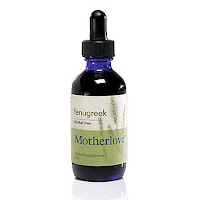The opinions, views and experiences shared in these reviews may not be the same as yours or others. Keep in mind different products perform differently for each person.
MotherLove
More milk special blend, more milk plus, fenugreek & malunggay: I decided to review these together instead of separately because thats how I took them. I have taken more milk special blend and more milk plus for years (capsule and liquid form)while nursing different children. It has always assisted in producing enough milk for my children. However it wasn't until this year that I started exclusively pumping and being able to measure my output. It also wasn't until this year that I added the MotherLove tinctures (fenugreek & malunggay). I can't say that the tinctures really did anything to increase my supply while I was already taking the more milk special blend supplements and the more milk plus supplements. With round the clock pumping my max output while using the MotherLove supplements was 18oz in a day. But my average was about 14oz. Overall I would recommend the more milk special blend and the more milk plus. The capsule and the liquid form work the same but I would recommend the capsule form to avoid the terrible taste of the liquid. Only con is that you need to wait 20 min before and after taking these before you can have any liquids. Maximum about of liquid you can drink with these is 2 oz. Keep in mind that fenugreek can upset the stomach of some. I did notice it makes me a little bit more gassy but that wasn't a deal breaker for me. It did not make any of my kids any gassier.
Legendairy Milk
Cash Cow:
Liquid gold: I tried these immediately coming off of using the MotherLove supplements (mentioned above). I did not see an increase in supply, however it did maintain the same supply as my MotherLove supplements I did however notice the fat content of my milk did increase.
Milkapalooza: I took these after trying Liquid Gold and my milk supply decreased significantly dropping to a mere 9 oz in a day. I took this in combination with Pump Princess when I saw my supply drop so low. Taking them both simultaneously had no effect.
Lechita:

Pump Princess: I took these while taking Milkapalooza in the hopes that it would help increase my supply after such a significant decrease. This did not help my supply in the least.
 Activist: This product sells out fast. I mean FAST. Its available through Legendairy Milk's etsy store found here. They email their customers when this product will be listed and you have got to be fast. 40 bottles of this sold out in about 60 seconds. I started taking this while taking Pump Princess in an effort to increase my supply from the nosedive it took after taking Milkapalooza. Recommended dosage is 1 dropper full 3-4 times a day. The thing is, when you fill the dropper, it is nowhere near an entire dropper full. It maybe fills up about 1/2 of the dropper. (see photo on the right)I saw no increase at all by filling it up as much as it would fill (1/2 of the way). Meanwhile I was also taking Pump Princess. I increased my dosage to 3 droppers (partially filled) 3 times a day. I did see a slight increase the first day of about 1 1/2 oz more by the end of the day. I didn't see much more of an increase for the month that I was using it. I decided to give it another try and buy it again to see if I just needed to give it more time. The second time around, it didn't sell out as fast because there were more in stock. But within about 5 minutes or so they were sold out of Lactivist. This time around I got the following note with my order when I received it: "Quick note: to suck up more of the liquid in the dropper, try squeezing the bulb twice in quick succession. If the dropper fills 1/2 to 2/3 of the way, that would be considered 1 dose. If you take 3 droppers a day, the bottle will last 3 weeks. 4 droppers a day will last 2 weeks. Happy milk making!" The tip did work in filling the dropper more fully.
Activist: This product sells out fast. I mean FAST. Its available through Legendairy Milk's etsy store found here. They email their customers when this product will be listed and you have got to be fast. 40 bottles of this sold out in about 60 seconds. I started taking this while taking Pump Princess in an effort to increase my supply from the nosedive it took after taking Milkapalooza. Recommended dosage is 1 dropper full 3-4 times a day. The thing is, when you fill the dropper, it is nowhere near an entire dropper full. It maybe fills up about 1/2 of the dropper. (see photo on the right)I saw no increase at all by filling it up as much as it would fill (1/2 of the way). Meanwhile I was also taking Pump Princess. I increased my dosage to 3 droppers (partially filled) 3 times a day. I did see a slight increase the first day of about 1 1/2 oz more by the end of the day. I didn't see much more of an increase for the month that I was using it. I decided to give it another try and buy it again to see if I just needed to give it more time. The second time around, it didn't sell out as fast because there were more in stock. But within about 5 minutes or so they were sold out of Lactivist. This time around I got the following note with my order when I received it: "Quick note: to suck up more of the liquid in the dropper, try squeezing the bulb twice in quick succession. If the dropper fills 1/2 to 2/3 of the way, that would be considered 1 dose. If you take 3 droppers a day, the bottle will last 3 weeks. 4 droppers a day will last 2 weeks. Happy milk making!" The tip did work in filling the dropper more fully. Mother's Milk
Mother's Milk Tea: This should be a staple in any breastfeeding mothers diet. I can't breastfeed and not have this. I literally start taking this as soon as I get to recovery in the hospital after giving birth. I ask for a hot cup of water and start taking the tea. You need to have at least 3 cups a day to see a difference. I also enjoy the taste. I probably would continue drinking this even if not lactating. Its that good. Keep in mind some mothers have reported it making them gassy. Ive also heard some mothers say it makes their baby gassy too. I personally have not had that experience.
Milkmakers
Milkmakers Oatmeal Chocolate Chip Lactation Cookies: I picked these up at my local Walmart. They tasted pretty good but I found them to be a little on the dry side. More importantly, I didn't see any increase after eating these. Keep in mind I only ate them once. I checked the bag as well as their website for recommended dosage amount and I didnt find anything. Im assuming you need to eat 2 cookies a day for a while to see any increase. However that is a big assumption on my part. I have nowhere to even check this information. The only thing I could find was on their website where it has a quote saying "100% of moms see an increase within a week". These weren't the cheapest cookies so I certainly didn't plan to buy 7 packs to have one each day of the week. And I certainly wouldn't want to buy even more to help milk production beyond that at that cost. I will add that they do sell Milkmakers as a bag of ingredients where you can prepare your own cookies too. So that might be more efficient. But not as cost efficient as making your own cookies at home.































